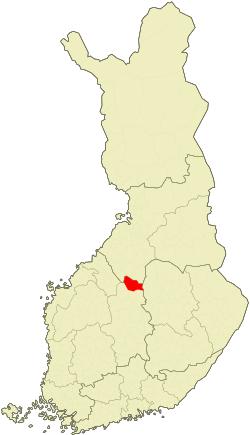Pihtipudas
It is located in northern Central Finland along the highway 4 (E75), about 140 kilometres (90 mi) north of Jyväskylä. The municipality has a population of 4,048 (31 January 2019)[2] and covers an area of 1,247.48 square kilometres (481.65 sq mi) of which 172.71 km2 (66.68 sq mi) is water.[1] There are all together 140 lakes in Pihtipudas. Biggest lakes are Alvajärvi, Muurasjärvi and Saanijärvi.[6] The population density is 3.77 inhabitants per square kilometre (9.8/sq mi).
Pihtipudas | |
|---|---|
Municipality | |
| Pihtiputaan kunta Pihtipudas kommun | |
Pihtipudas Church | |
 Coat of arms | |
 Location of Pihtipudas in Finland | |
| Coordinates: 63°22′N 025°34.5′E | |
| Country | |
| Region | Central Finland |
| Sub-region | Saarijärvi–Viitasaari sub-region |
| Government | |
| • Municipal manager | Ari Kinnunen |
| Area (2018-01-01)[1] | |
| • Total | 1,247.48 km2 (481.65 sq mi) |
| • Land | 1,074.76 km2 (414.97 sq mi) |
| • Water | 172.71 km2 (66.68 sq mi) |
| Area rank | 72nd largest in Finland |
| Population (2019-01-31)[2] | |
| • Total | 4,048 |
| • Rank | 198th largest in Finland |
| • Density | 3.77/km2 (9.8/sq mi) |
| Population by native language | |
| • Finnish | 99.4% (official) |
| • Others | 0.6% |
| Population by age | |
| • 0 to 14 | 17.4% |
| • 15 to 64 | 59.4% |
| • 65 or older | 23.3% |
| Time zone | UTC+02:00 (EET) |
| • Summer (DST) | UTC+03:00 (EEST) |
| Municipal tax rate[5] | 19.5% |
| Website | www.pihtipudas.fi |
Pihtipudas is a municipality of Finland.
The municipality is unilingually Finnish.
Pihtipudas is perhaps best known for the annual javelin carnival and Lauri "Tahko" Pihkala, the father of Finnish baseball. Putaanportti area offers plenty of services for travelers. Fish Art is a sales exhibition of taxidermic (mounted fish) – unique in Finland. Close to the service station there are shops – in a way factory outlets – specialized in sweets, leather bags and pottery products. Other tourist services are found in the central village and lakeside areas.
Attractions
The scenery and history of Pihtipudas are easy to be found hand in hand on the bridge of Heinäjoki. Local museum and the church are next to each other in the center of Pihtipudas. Places worth mentioning are also Niemenharju area with well-known dancing place, an old demarcation Rillankivi and lake Alvajärvi area.
Buildings and Structures
- 321 metres tall guyed TV-mast built in 1972
Twin towns
Gallery
- Street in Pihtipudas
- Pihtipudas Military Cemetery
 Interior of Pihtipudas Church
Interior of Pihtipudas Church Muurasjärvi Church
Muurasjärvi Church Heinäjoki Bridge
Heinäjoki Bridge
References
- "Area of Finnish Municipalities 1.1.2018" (PDF). National Land Survey of Finland. Retrieved 30 January 2018.
- "Suomen virallinen tilasto (SVT): Väestön ennakkotilasto [verkkojulkaisu]. Tammikuu 2019" (in Finnish). Statistics Finland. Retrieved 15 March 2019.
- "Population according to language and the number of foreigners and land area km2 by area as of 31 December 2008". Statistics Finland's PX-Web databases. Statistics Finland. Retrieved 29 March 2009.
- "Population according to age and gender by area as of 31 December 2008". Statistics Finland's PX-Web databases. Statistics Finland. Retrieved 28 April 2009.
- "List of municipal and parish tax rates in 2011". Tax Administration of Finland. 29 November 2010. Retrieved 13 March 2011.
- "Pihtipudas)". Järviwiki. Finland's Environmental Administration. 2012. Retrieved 27 February 2012.
- "Ystäväkuntalista" (PDF) (in Finnish). Pohjola-Norden. Retrieved 7 May 2012.
- "Vennskapskommune samarbeide i Norden" (in Icelandic). Borgarbyggð Municipality. Archived from the original on 17 February 2012. Retrieved 7 May 2012.
- "Ystäväkuntalista" (PDF) (in Finnish). Pohjola-Norden. Retrieved 7 May 2012.
- "Ystäväkuntalista" (PDF) (in Finnish). Pohjola-Norden. Retrieved 7 May 2012.
- "Ystäväkuntalista" (PDF) (in Finnish). Pohjola-Norden. Retrieved 7 May 2012.
External links
![]()
- Municipality of Pihtipudas – Official website, finnish, english